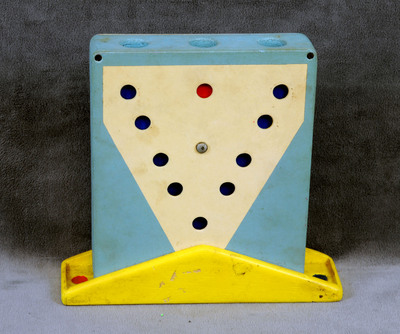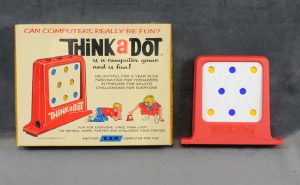You don’t have to think a lot to play Think-a-Dot… unless you really want to!
The game that would become the Think-a-Dot started out as a concept called Magic Marbles in one of Weisbecker’s personal notebooks from 1963.[1] From there, he changed the game’s name to Magic Spots, a game that promised fun for “preschoolers, PhDs, and almost everyone else, and built a working prototype with playing instructions.[2] The concept was later patented as US3388483A, a computer-type game and teaching aid. While this game, as the language of the patent suggests, had the “inherent predictability of a computer,” it still had a “psychologically attractive degree of mystery.” It thus served a dual purpose: it provided insight into how computer memory and automata theory worked for players “of higher intellectual level,” while at the same time providing entertainment in the form of a puzzle for the younger set.[3] This was Weisbecker’s first commercially successful game, because in 1965, it was licensed by E.S.R. Inc., a New Jersey manufacturer of educational toys, where it was given its new name, Think-a-Dot.

E.S.R.’s first toy, the Digi-Comp, was a simple mechanical computer, and it was joined by other computer-type games, including Dr. NIM, and Weisbecker’s Think-a-Dot. The latter came out on the market in 1966 as a plastic toy with three holes on top through which a ball was dropped, triggering a disk in the front of the game to turn either blue or yellow. These flipped disks would, in turn, determine the paths of subsequent balls. This meant a mesmerizing game with 265 possible patterns, with the added challenge of determining the way each channel would flip with the introduction of the marbles. It was an immediate success for both E.S.R. and Weisbecker, not only for its inherent entertainment possibilities, but also because it promised its players greater insight into the world of computers. This was no small thing: early advertisements for the game, like one in the British hobbyist magazine Meccano stressed exactly this. “Computer,” this advertisement read, “is now headline news. It plays a vital role in our world and in the world of the future. It is an essential new science for you to understand.”[4] And Electronix Limited (E.S.R.’s British distributor), was quick to stress the game’s ability to train young minds in the machines of the future because of the gamification of key principles in computer logic.

It was also used in educational therapy—as Weisbecker wrote to game designer Sid Sackson in 1969, it was being used to help children with left-right discrimination problems.[5] Its popularity and usefulness meant it was mentioned three times in Mathematics Magazine, which praised “the richness of [the game’s] mathematical theory, […] built on so modest a foundation,”[6] and whose final article about the game appeared in 1979 suggests that it as a teaching tool, it was still in use well into the end of the 1970s.
Neither its educational usefulness nor its entertainment value has waned in the 21st century, and modern-day players can play a simulated version made with MIT Media Lab’s Scratch, or download a Think-a-Dot app for Android. For the more intrepid tinkerers, Joseph Weisbecker published instructions for how to build a Think-a-Dot-type computer called FLIP in the May 1974 issue of Popular Mechanics. However, if you like the satisfaction that comes from playing with plastic, drop by the collection to play on one of our original 1965 Think-a-Dot, on display as part of our new exhibition, Playing with Innovation: The Games of Joseph Weisbecker.
Do you remember playing with Think-a-Dot as a child, or are you planning on building Weisbecker’s FLIP (instructions can be found on page 58 of this issue of Popular Electronics)? Let our curator know at pierrif@tcnj.edu, she’d love to hear from you!
Text by Florencia Pierri
Citations:
[1] Joseph Weisbecker, personal notebook, Hagley Museum and Library, David Sarnoff Research Center Records, 2464.09, record group 11, series VII, Box 871, Folder 11, p. 7.
[2] Magic Spots instructions, Hagley Museum and Library, David Sarnoff Research Center Records, 2464.09, record group 11, series VII, box 870, folder 25.
[3] Joseph Weisbecker, US Patent 3,388,483, filed July 21, 1966.
[4] “Five Computers,” in Meccano Magazine, January 1968, p. 46.
[5] Joseph Weisbecker to Sid Sackson, November 7, 1969. Hagley Museum and Library, David Sarnoff Research Center Records, 2464.09, record group 11, series VII, Box 870, folder 24.
[6] Benjamin L. “Mathematical Theory of Think-a-Dot.” Mathematics Magazine, vol. 40, no. 4, 1967, pp. 187–193.

